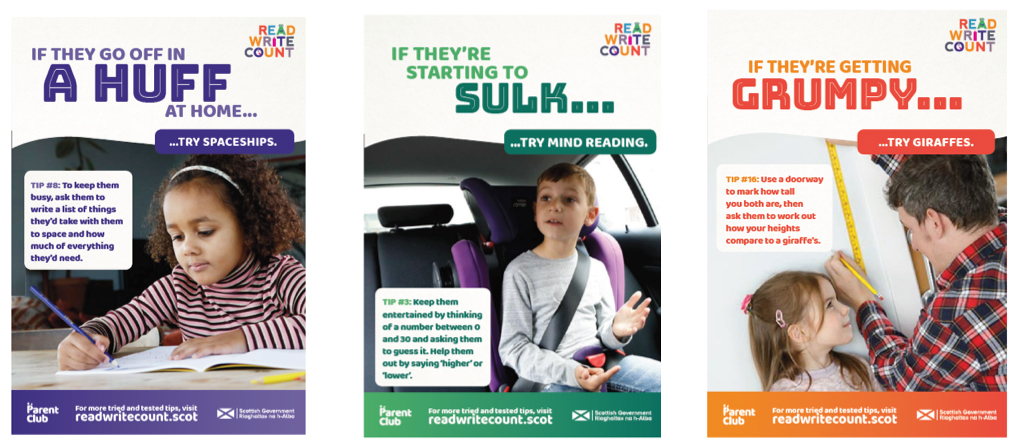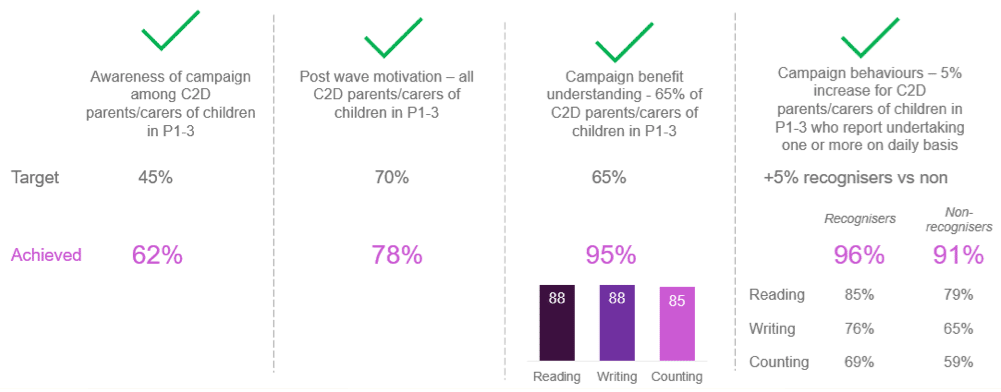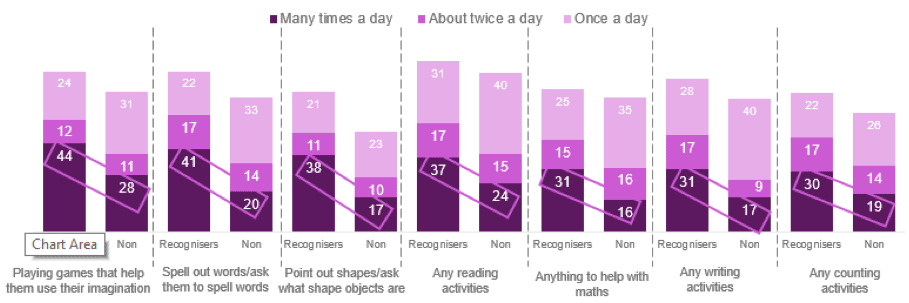Read, Write, Count: November 2017 campaign evaluation report
Summary of the Read, Write, Count primary school literacy campaign results against its objectives.
Read, Write, Count November 2017 Campaign Evaluation Report
Background
A key priority set out in the 2017 Programme for Government was the commitment to closing the poverty related attainment gap - due to the contribution this makes to health, happiness and fulfilment of all of us as individuals, and how it supports a successful, dynamic economy.
Underpinning this ambition are a range of Scottish Government initiatives designed to support our young people and reduce inequalities.
Read, Write, Count is one such initiative - a national programme which aims to create a positive culture around confident learning in the homes of all primary school children (P1-3) across Scotland, particularly around literacy and numeracy. It aims to increase parents' and carers' involvement in their child's learning at home and helps them use resources provided to support this.
Read, Write, Count incorporates a number of elements, including this marketing campaign, to encourage parents and carers of primary school aged children to get involved in their child's learning, particularly literacy and numeracy.
Objectives
A range of objectives were set for the Read, Write, Count marketing campaign, based on benchmarks from past campaigns. The campaign aimed to achieve, among the target audience (C2D parents/carers of children in P1-3):
- 45% awareness of campaign
- 70% motivation among those who have seen the campaign
- 65% comprehension rate (understand the benefits as mentioned in the campaign of interacting more with their children)
- 5 percentage point increase in behaviours mentioned in the campaign
Campaign development and delivery
The 2017 Read, Write, Count campaign ran under the Scottish Government's Parental Audience communications strategy. The creative routes were tested in focus groups in October 2017 with the target audience, to ensure that the creative executions were effective in terms of delivering on the campaign objectives.
Core to the new campaign strategy was the insight that while parents understood the educational benefits of reading, writing and counting activities, the pressures of family life often meant that they felt there was no time to undertake these 'additional asks'. However, by demonstrating how these activities can act as solutions to common daily challenges, parents were more receptive to these activities.
Three outdoor executions were developed, demonstrating literacy and numeracy activities that parents could adopt to help prevent problematic situations before they started (as these were situations all parents related to, where they would appreciate support and therefore highly motivating):

A digital film was also developed, demonstrating understanding of how chaotic family life can be, encouraging parents to create some calm in the family day by spending time with their child undertaking literacy and numeracy activities - https://www.youtube.com/watch?v=7MElP8KjL54
In addition two radio adverts were developed.
The campaign ran from 6 November to 4 December 2017 and included digital, outdoor, press and radio activity. The Read, Write, Count website was updated to reflect the new campaign, and activity was pushed out via the Read, Write, Count Facebook and Twitter accounts.
Details of the campaign media plan are provided below.
| Media Schedule % of spend |
October | November | December | |||||
|---|---|---|---|---|---|---|---|---|
| 30th | 6th | 13th | 20th | 27th | 4th | 11th | 18th | |
| Digital 25% | ||||||||
| Admaxim banners & Facebook content | 6th - 27th Nov | |||||||
| Digital PPC | 6th - 27th Nov | |||||||
| Outdoor 35% | ||||||||
| 6 Sheets | 6th - 27th Nov | |||||||
| Press 16% | ||||||||
| News Scotland Newsbrand Partnership | 6th - 27th Nov | |||||||
| Radio 24% | ||||||||
| Commercial & Community Stations | 13th - 4th Dec | |||||||
Evaluation
A campaign tracking survey was carried out between December 2017 and January 2018. This was conducted by an independent research agency, Kantar TNS, who used a face-to-face, in-street quota based survey as the vehicle for data collection. Interviews were conducted with C2D parents with children in P1-P3 with representative sample points across Scotland.
Key results against the campaign objectives are shown in the chart below.[1]

- 62% prompted recognition of any element of the campaign, well above the target of 45%, set at the start of the campaign.[2]
- The digital (39%) and radio (37%) were the prominent channels driving recognition, supported by posters (21%) and newspapers (12%).[2]
- Campaign key messages were well understood, in particular the message of spending quality time with your child (51% 'Spend time / help your children').[3]
- The campaign was motivating 78% of the target audience, which was an increase from the previous Read, Write, Count activity and the target of 70%.[3]
- Almost all of the audience (95%) understood at least one of the immediate benefits (as described by the campaign[4]) of undertaking reading, writing or counting activities with their child.[2]
- These benefits were equally recognised across reading (88%), writing (88%) and counting (85%).[2]
- The results indicate that the campaign was successful in encouraging parents to adopt reading, writing and counting activities into their daily life. Comparing daily participation in behaviours for those who had seen the campaign versus those who had not, we achieved:
- 6 percentage point increase in daily reading.
- 11 percentage point increase in daily writing.
- 10 percentage point increase in daily counting[5].
- The results for counting behaviours is particularly successful, as previous campaigns have had limited impact on this.
- Those who had seen the campaign were also more likely to undertake a wide range of in home learning activities much more frequently than those who hadn't seen the campaign (see below).[5]

In addition to the independent campaign evaluation, Google Analytics were used to understand how parents engaged with the website. The results indicate that the campaign built on previous campaigns, driving even more parents to the website and encouraging deeper engagement.
Specifically this campaign saw:
- An increase of 17% of people using the website.
- 85% increase in the number of pages users visited.
- Average time on site increased by 75%.[6]
Conclusions and Recommendations
The campaign performed very well with high overall visibility and the mix of media used successfully reached a range of groups within the target audience with messages that resonated. Future campaigns should continue with this media mix.
The messaging around spending quality time with children and its benefits landed with the target audience. Importantly, the campaign tapped into immediate benefits that parents believe in (avoiding bad behaviour and making parents' lives easier), making the messaging credible and motivating.
The campaign achieved good levels of claimed action and participation. Future activity should continue to emphasise the 'fun' aspect of quality time with children, featuring activities that are easily incorporated into daily life and meet immediate parental needs.
Presenting easily-adopted literacy and numeracy activities as solutions to daily family challenges could build on the campaign impact by further strengthening interest in adopting behaviours in future.
Contact
Email: The Parent Club Team
There is a problem
Thanks for your feedback